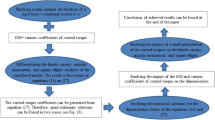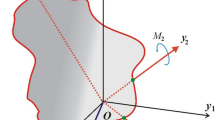Abstract
AUTOROTATION is the rotation of an object in an airstream in the absence of any other driving force1. It is important in the fall characteristics of some tree fruits, the growth of hailstones, and the trajectories of objects separating from aircraft and spacecraft. Previous studies have concentrated on thin, flat plates rotating about an axis normal to the airstream, but in many applications— those relating to the free fall of bodies through air—the behaviour of bodies of more complex geometry is of interest. When these autorotate, a lift force is generated which can significantly alter the body's trajectory. Here I examine the autorotation of prisms whose cross-sections are regular polygons. Prisms of triangular section rotate fastest, but generate less lift than a flat plate. Only bodies with less than eight sides are found to show autorotational behaviour. In all of these cases, the lift forces generated are larger than those obtained from a spinning cylinder driven externally at the same rotation speed. Many devices have been proposed in the past that use as a propulsion mechanism the lift force developed on a driven rotating cylinder, perhaps the most spectacular being the Flettner rotorship which crossed the Atlantic in 19262. The use of polygonal bodies would have application in these cases, not only because of the higher lift generated but also because the energy required may be derived simply from the relative wind. There are thus also clear implications for wind-power devices.
This is a preview of subscription content, access via your institution
Access options
Subscribe to this journal
Receive 51 print issues and online access
$199.00 per year
only $3.90 per issue
Buy this article
- Purchase on Springer Link
- Instant access to full article PDF
Prices may be subject to local taxes which are calculated during checkout
Similar content being viewed by others
References
Lugt, H. J. Ann. Rev. Fluid Mech. 15, 123–147 (1983).
Swanson, W. M. J. basic Engng 82, 461–470 (1961).
Lugt, H. J. J. Fluid Mech. 99, 817–840 (1980).
Magnus, G. Poggendorfer Ann. Phys. 88, 604 (1853).
Maxwell, J. C. Camb. Dublin Math. J. 9, 145 (1854).
Iverson, J. D. J. Fluid Mech. 92, 327–348 (1979).
Skews, B. W. J. Fluid Mech. 217, 33–40 (1990).
Kuethe, A. M. & Schetzer, J. D. Foundations of Aerodynamics, 2nd Edn (Wiley, New York, 1959).
Riabouchinsky, D. P. J. Royal aeronaut. Soc. 39, 282–348; 377–444 (1935).
Author information
Authors and Affiliations
Rights and permissions
About this article
Cite this article
Skews, B. Autorotation of many-sided bodies in an airstream. Nature 352, 512–513 (1991). https://doi.org/10.1038/352512a0
Received:
Accepted:
Issue Date:
DOI: https://doi.org/10.1038/352512a0
This article is cited by
-
Mechanism of autorotation flight of maple samaras (Acer palmatum)
Experiments in Fluids (2014)
-
Flow past polygons with an odd number of edges
Science China Physics, Mechanics and Astronomy (2011)
Comments
By submitting a comment you agree to abide by our Terms and Community Guidelines. If you find something abusive or that does not comply with our terms or guidelines please flag it as inappropriate.



